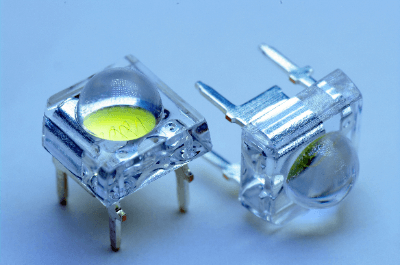What Are LED Lenses?
 LED Lenses are a special lens used to adjust LED light to make them easier to use.
LED Lenses are a special lens used to adjust LED light to make them easier to use.
The light emitted by LEDs is characterized by its high linearity and lack of spread. It is used to illuminate a larger area with a small amount of power.
It is because the light is diffused by passing through this special lens that energy saving and brightness can be realized at the same time. For lighting purposes, the lenses are divided into various applications and number of light sources depending on the shape of the lens.
Lighting using LEDs as the light source are currently being introduced in many places in addition to home use. In order to accommodate a wide range of applications, they are incorporated into fixtures together with LED lenses.
Uses of LED Lenses
LED lenses are often incorporated inside lighting fixtures that utilize LED light sources, and because LED lighting is cost-effective, it is becoming popular in a wide range of locations such as retail and residential lighting, advertising lighting, street lighting, stage lighting, outdoor lighting, flashlights, and measuring instruments.
In addition to the many uses of LED lighting in hotels, showrooms, and museums, LED lighting and LED lenses are being introduced for special applications such as exhibits. Furthermore, in addition to lighting applications, they are also used in signal lights and road traffic signs.
These are indispensable to modern life because of their durability, long life, and reliability that can be applied outdoors.
Principle of LED Lenses
LED lenses can spread the highly linear light of LED elements evenly by collecting, refracting, and diffusing the light.
LED lenses are formed in a LED light source package, which is commercialized as an electronic component and can be used. Depending on the shape of the package, the lenses also differs greatly.
Features of LED Lenses
LED lenses have different characteristics depending on the type. The features that vary by type are as follows:
1. Light Collection
A simple dome-shaped lens, often used in transparent resin-covered packages, is suitable for LEDs used in lighting applications, and is often used in inexpensive flashlights because it concentrates and illuminates a small light source emitted from LED lens elements.
2. Light Distribution and Diffusion
Light distribution is classified according to the angle and intensity of light.
Light distribution is called Lambertian light distribution when the light has a high forward directivity, is bright in the center, and becomes gradually darker as it moves away from the center of the light.
Other types include omni-directional types that can illuminate the entire area and wide light distribution types that can illuminate in a semicircle. Lenses that diffuse light are best suited for lighting signboards and other applications where you want to illuminate a wide area evenly.
Since the impression of light varies greatly depending on the distance from the LED light source, the LED lens and the distance from the light source should be determined according to the desired light distribution.
3. Durability
Some LED lenses have excellent durability. LEDs used in traffic signals and road traffic signs are susceptible to rain, dust, and other external environmental influences, so they deteriorate quickly.
To maintain the longevity that is a characteristic of LEDs, LED lenses plays a role in protecting the inside. LED lenses are also sensitive to moisture. Therefore, even if LED lenses are not used outdoors, it is necessary to select a lens that is resistant to moisture when installed in a humid place.
4. Variety of Shapes
The dome or triangular pyramid shape usually used in many applications could not improve the thickness of the lens. In recent years, however, very thin lenses processed into a flat shape have been developed. These lenses have the versatility to be applied to thin signboards, etc., which was previously impossible.